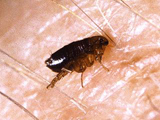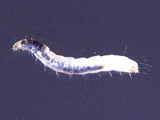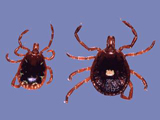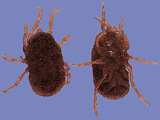Fleas and Ticks
Fleas and ticks are the most important external parasites of pets, livestock and humans. Both fleas and ticks are very abundant, have irritating bites and can transmit disease. Fleas can transmit tapeworms. Ticks can transmit Lyme disease, Rocky Mountain spotted fever and relapsing fever. Lyme disease is transmitted in the Northern United States by the deer tick and in the Southern United States by the black legged, Gulf coast, American dog, lone star and relapsing fever tick. Lone star and American dog ticks can cause tick paralysis.
The following gallery of fleas and ticks will help you determine what type of flea or tick pest problem you might be encountering. All of the pictures show here are from James Castner from the University of Florida.
Picture |
Name |
Description |
 |
American Dog Tick | This tick is one of the most prevalent tick pests in the Eastern United States. Adults are about 1/4" long, and the shield has variable white markings. The larvae and nymphs prefer to feed on mice. Adults prefers dogs and other large animals. |
 |
Black-legged Tick |
This tick is widespread in the Southeastern United States, and often is found along trails, paths and roadways. Adult ticks are dark reddish-brown with dark-brown to black legs. |
 |
Brown Dog Tick | This tick is one of the most common pests of dogs. Adults are 3/16" long and are uniformly reddish-brown. All stages prefer to feed on dogs. This tick is prevalent in houses and kennels. |
 |
Cat Flea | The cat flea is the most important flea species in the United States and attacks both cats and dogs. Adults are 1/16" long and are usually found on the host. The flea inserts its mouthparts in the skin, injects saliva and sucks blood. The bite leaves a red spot on the skin. The saliva is irritating to the host, causing dermatitis and hair loss in allergic animals. |
 |
Flea Cocoons |
Flea larvae pupate within silken cocoons and change into the adult stage. Debris is incorporated into the cocoon, so they are difficult to find. Fleas can remain in the pupal stage for six to 12 months without a host. They are protected from insecticides and resist chemical treatments. |
 |
Flea Eggs and Feces | Adult female fleas lay white, shiny eggs on the host. The eggs are not glued to the host, so they fall off immediately into bedding and other areas. Adult flea feces are also found in areas the animals frequent. Female fleas can produce 24 eggs per day, and eggs hatch in 12 to 48 hours. |
 |
Flea Larva | Larvae of fleas go through three stages in 10 to 14 days. They are about 1/4" long. Larvae prefer to feed on adult flea feces. They are mainly found in pet resting areas, both indoors and outdoors. |
 |
Gulf Coast Tick | This tick is very prevalent in the Southeastern United States. The sexes are very different in appearance. The immature stages feed on ground-dwelling birds. Adults attach primarily to the ears of large animals such as deer and cattle. |
 |
Lone Star Tick | This tick is one of the most common ticks on humans and it has prevented the development of some areas. The female has a silvery spot on the dorsal shield. Its long mouthparts allow deep penetration of the skin, often causing pus sores. |
 |
Relapsing Fever Tick | The relapsing fever tick is a soft tick, and its mouthparts are not visible from above. The relapsing fever tick mainly attacks rodents, and consequently is associated with rat and mouse habitats. It can transmit tick-borne relapsing fever. |
Material on this page comes from: P.G. Koehler, Professor; J.L. Castner, Scientific Photographer; Department of Entomology and Nematology, Cooperative Extension Service, Institute of Food and Agricultural Sciences, University of Florida, Gainesville, 32611.
